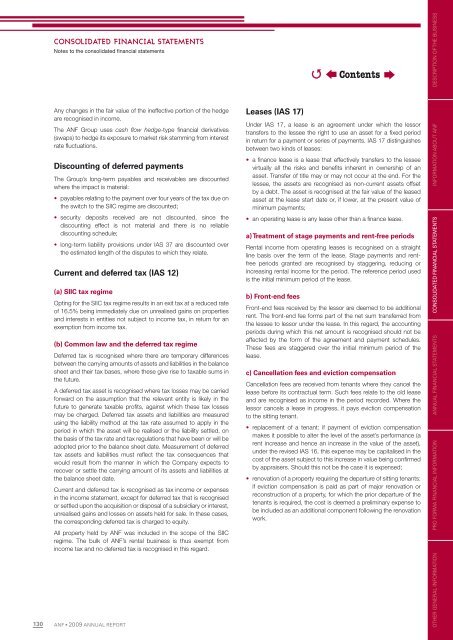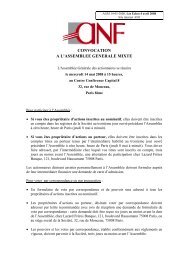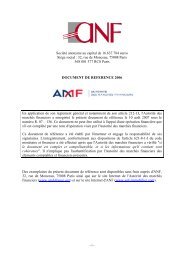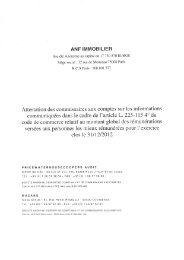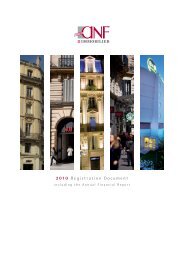Download the 2009 annual report in PDF format - ANF
Download the 2009 annual report in PDF format - ANF
Download the 2009 annual report in PDF format - ANF
Create successful ePaper yourself
Turn your PDF publications into a flip-book with our unique Google optimized e-Paper software.
130<br />
CONSOLIDATED FINANCIAL STATEMENTS<br />
Notes to <strong>the</strong> consolidated fi nancial statements<br />
Any changes <strong>in</strong> <strong>the</strong> fair value of <strong>the</strong> <strong>in</strong>effective portion of <strong>the</strong> hedge<br />
are recognised <strong>in</strong> <strong>in</strong>come.<br />
The <strong>ANF</strong> Group uses cash fl ow hedge-type fi nancial derivatives<br />
(swaps) to hedge its exposure to market risk stemm<strong>in</strong>g from <strong>in</strong>terest<br />
rate fl uctuations.<br />
Discount<strong>in</strong>g of deferred payments<br />
The Group’s long-term payables and receivables are discounted<br />
where <strong>the</strong> impact is material:<br />
• payables relat<strong>in</strong>g to <strong>the</strong> payment over four years of <strong>the</strong> tax due on<br />
<strong>the</strong> switch to <strong>the</strong> SIIC regime are discounted;<br />
• security deposits received are not discounted, s<strong>in</strong>ce <strong>the</strong><br />
discount<strong>in</strong>g effect is not material and <strong>the</strong>re is no reliable<br />
discount<strong>in</strong>g schedule;<br />
• long-term liability provisions under IAS 37 are discounted over<br />
<strong>the</strong> estimated length of <strong>the</strong> disputes to which <strong>the</strong>y relate.<br />
Current and deferred tax (IAS 12)<br />
(a) SIIC tax regime<br />
Opt<strong>in</strong>g for <strong>the</strong> SIIC tax regime results <strong>in</strong> an exit tax at a reduced rate<br />
of 16.5% be<strong>in</strong>g immediately due on unrealised ga<strong>in</strong>s on properties<br />
and <strong>in</strong>terests <strong>in</strong> entities not subject to <strong>in</strong>come tax, <strong>in</strong> return for an<br />
exemption from <strong>in</strong>come tax.<br />
(b) Common law and <strong>the</strong> deferred tax regime<br />
Deferred tax is recognised where <strong>the</strong>re are temporary differences<br />
between <strong>the</strong> carry<strong>in</strong>g amounts of assets and liabilities <strong>in</strong> <strong>the</strong> balance<br />
sheet and <strong>the</strong>ir tax bases, where <strong>the</strong>se give rise to taxable sums <strong>in</strong><br />
<strong>the</strong> future.<br />
A deferred tax asset is recognised where tax losses may be carried<br />
forward on <strong>the</strong> assumption that <strong>the</strong> relevant entity is likely <strong>in</strong> <strong>the</strong><br />
future to generate taxable profi ts, aga<strong>in</strong>st which <strong>the</strong>se tax losses<br />
may be charged. Deferred tax assets and liabilities are measured<br />
us<strong>in</strong>g <strong>the</strong> liability method at <strong>the</strong> tax rate assumed to apply <strong>in</strong> <strong>the</strong><br />
period <strong>in</strong> which <strong>the</strong> asset will be realised or <strong>the</strong> liability settled, on<br />
<strong>the</strong> basis of <strong>the</strong> tax rate and tax regulations that have been or will be<br />
adopted prior to <strong>the</strong> balance sheet date. Measurement of deferred<br />
tax assets and liabilities must refl ect <strong>the</strong> tax consequences that<br />
would result from <strong>the</strong> manner <strong>in</strong> which <strong>the</strong> Company expects to<br />
recover or settle <strong>the</strong> carry<strong>in</strong>g amount of its assets and liabilities at<br />
<strong>the</strong> balance sheet date.<br />
Current and deferred tax is recognised as tax <strong>in</strong>come or expenses<br />
<strong>in</strong> <strong>the</strong> <strong>in</strong>come statement, except for deferred tax that is recognised<br />
or settled upon <strong>the</strong> acquisition or disposal of a subsidiary or <strong>in</strong>terest,<br />
unrealised ga<strong>in</strong>s and losses on assets held for sale. In <strong>the</strong>se cases,<br />
<strong>the</strong> correspond<strong>in</strong>g deferred tax is charged to equity.<br />
All property held by <strong>ANF</strong> was <strong>in</strong>cluded <strong>in</strong> <strong>the</strong> scope of <strong>the</strong> SIIC<br />
regime. The bulk of <strong>ANF</strong>’s rental bus<strong>in</strong>ess is thus exempt from<br />
<strong>in</strong>come tax and no deferred tax is recognised <strong>in</strong> this regard.<br />
<strong>ANF</strong> • <strong>2009</strong> ANNUAL REPORT<br />
Leases (IAS 17)<br />
Under IAS 17, a lease is an agreement under which <strong>the</strong> lessor<br />
transfers to <strong>the</strong> lessee <strong>the</strong> right to use an asset for a fi xed period<br />
<strong>in</strong> return for a payment or series of payments. IAS 17 dist<strong>in</strong>guishes<br />
between two k<strong>in</strong>ds of leases:<br />
• a fi nance lease is a lease that effectively transfers to <strong>the</strong> lessee<br />
virtually all <strong>the</strong> risks and benefi ts <strong>in</strong>herent <strong>in</strong> ownership of an<br />
asset. Transfer of title may or may not occur at <strong>the</strong> end. For <strong>the</strong><br />
lessee, <strong>the</strong> assets are recognised as non-current assets offset<br />
by a debt. The asset is recognised at <strong>the</strong> fair value of <strong>the</strong> leased<br />
asset at <strong>the</strong> lease start date or, if lower, at <strong>the</strong> present value of<br />
m<strong>in</strong>imum payments;<br />
• an operat<strong>in</strong>g lease is any lease o<strong>the</strong>r than a fi nance lease.<br />
a) Treatment of stage payments and rent-free periods<br />
Rental <strong>in</strong>come from operat<strong>in</strong>g leases is recognised on a straight<br />
l<strong>in</strong>e basis over <strong>the</strong> term of <strong>the</strong> lease. Stage payments and rentfree<br />
periods granted are recognised by stagger<strong>in</strong>g, reduc<strong>in</strong>g or<br />
<strong>in</strong>creas<strong>in</strong>g rental <strong>in</strong>come for <strong>the</strong> period. The reference period used<br />
is <strong>the</strong> <strong>in</strong>itial m<strong>in</strong>imum period of <strong>the</strong> lease.<br />
b) Front-end fees<br />
�<br />
Contents<br />
Front-end fees received by <strong>the</strong> lessor are deemed to be additional<br />
rent. The front-end fee forms part of <strong>the</strong> net sum transferred from<br />
<strong>the</strong> lessee to lessor under <strong>the</strong> lease. In this regard, <strong>the</strong> account<strong>in</strong>g<br />
periods dur<strong>in</strong>g which this net amount is recognised should not be<br />
affected by <strong>the</strong> form of <strong>the</strong> agreement and payment schedules.<br />
These fees are staggered over <strong>the</strong> <strong>in</strong>itial m<strong>in</strong>imum period of <strong>the</strong><br />
lease.<br />
c) Cancellation fees and eviction compensation<br />
Cancellation fees are received from tenants where <strong>the</strong>y cancel <strong>the</strong><br />
lease before its contractual term. Such fees relate to <strong>the</strong> old lease<br />
and are recognised as <strong>in</strong>come <strong>in</strong> <strong>the</strong> period recorded. Where <strong>the</strong><br />
lessor cancels a lease <strong>in</strong> progress, it pays eviction compensation<br />
to <strong>the</strong> sitt<strong>in</strong>g tenant.<br />
• replacement of a tenant: if payment of eviction compensation<br />
makes it possible to alter <strong>the</strong> level of <strong>the</strong> asset’s performance (a<br />
rent <strong>in</strong>crease and hence an <strong>in</strong>crease <strong>in</strong> <strong>the</strong> value of <strong>the</strong> asset),<br />
under <strong>the</strong> revised IAS 16, this expense may be capitalised <strong>in</strong> <strong>the</strong><br />
cost of <strong>the</strong> asset subject to this <strong>in</strong>crease <strong>in</strong> value be<strong>in</strong>g confi rmed<br />
by appraisers. Should this not be <strong>the</strong> case it is expensed;<br />
• renovation of a property requir<strong>in</strong>g <strong>the</strong> departure of sitt<strong>in</strong>g tenants:<br />
if eviction compensation is paid as part of major renovation or<br />
reconstruction of a property, for which <strong>the</strong> prior departure of <strong>the</strong><br />
tenants is required, <strong>the</strong> cost is deemed a prelim<strong>in</strong>ary expense to<br />
be <strong>in</strong>cluded as an additional component follow<strong>in</strong>g <strong>the</strong> renovation<br />
work.<br />
OTHER GENERAL INFORMATION PRO FORMA FINANCIAL INFORMATION ANNUAL FINANCIAL STATEMENTS CONSOLIDATED FINANCIAL STATEMENTS INFORMATION ABOUT <strong>ANF</strong> DESCRIPTION OF THE BUSINESS


